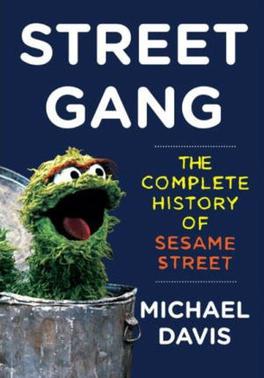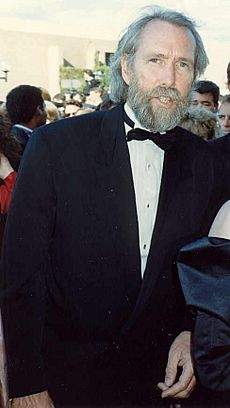Street Gang facts for kids

Street Gang: The Complete History of Sesame Street
|
|
| Author | Michael Davis |
|---|---|
| Country | United States |
| Language | English |
| Published | 2008 |
| Publisher | Viking Press |
| Pages | 380 |
| ISBN | 9780670019960 |
Street Gang: The Complete History of Sesame Street is a non-fiction book chronicling the history of the children's television program, Sesame Street. Street Gang is journalist and writer Michael Davis's first book, published by Viking Press in 2008. On bookshelves in time for the show's 40th anniversary in 2009, the book developed out of a TV Guide article Davis wrote to commemorate the show's 35th anniversary in 2004. Davis spent five years researching and writing the book, and conducted hundreds of interviews with the show's creators, cast, and crew.
Street Gang begins with a description of Muppet creator Jim Henson's 1990 funeral, from the perspective of co-creator Joan Ganz Cooney. Its first twelve chapters describe the origin, development, and early years of Sesame Street and the Children's Television Workshop, the organization created to oversee the production of the show and other projects. Davis includes the biographies of many of the key people involved with the creation and production of Sesame Street. Subsequent chapters chronicle the rest of the show's history, up to its 40th anniversary in 2009.
Reviews of Street Gang were mostly positive. Most reviewers were impressed by Davis' research and attention to detail, but some felt that it was too episodic and was more of an oral history than a dispassionate history of the show's history. One reviewer predicted that the book would become the definitive source of Sesame Street. Street Gang was made into an audio book, narrated by Caroll Spinney, the same day it was published. A second edition was published later that year. The 2021 documentary Street Gang: How We Got to Sesame Street directed by Marilyn Agrelo is based on the book.
Background
Michael Davis, a senior editor for TV Guide from 1998 to 2007, wrote an article in the magazine to commemorate the 35th anniversary of the children's television show Sesame Street in 2004. Street Gang developed out of the article. Davis spent five years researching and writing the book and worked with the cooperation of co-creator Joan Ganz Cooney.
In 2009, Sesame Street celebrated its 40th anniversary. It was the fifteenth-highest rated children's television show in the United States and had won 8 Grammy Awards and over 100 Emmy Awards—more than any other children's show. By 2006, there were independently produced versions, or "co-productions", of Sesame Street broadcast in twenty countries. In 2001 there were over 120 million viewers of these international versions, and by 2009, it was broadcast in more than 140 countries. A 1996 survey found that 95% of all American preschoolers had watched the show by the time they were three years old. In 2008, it was estimated that 77 million Americans had watched the series as children.
Summary
Prologue: A description of the funeral of Muppet creator Jim Henson in New York City in 1990, from the viewpoint of Joan Ganz Cooney, one of the creators of Sesame Street.
Chapters 1—12: The origins and development of the show and the creation of the Children's Television Workshop (CTW). Sesame Street was created after a dinner party hosted by Cooney and her husband in early 1966, attended by Carnegie Foundation vice-president Lloyd Morrisett and Cooney's boss at New York City educational television station WNDT, Lewis Freedman. The discussion inspired them to create a children's television program, different than what was offered at the time, that could "master the addictive qualities of television" and help young children, especially from low-income families, learn and prepare for school. Davis includes the biographies of key players in the show's development: Cooney, Morrisett, Jon Stone, Sam Gibbon, Tom Whedon, Evelyn Payne Davis, Jim Henson, Caroll Spinney, Gerald S. Lesser, Edward Palmer, Joe Raposo, Loretta Long, Bob McGrath, Will Lee, and Matt Robinson. There is also a discussion of the history of early children's television; specifically, Captain Kangaroo and The Howdy Doody Show. Davis emphasizes the coincidence that many involved with the show had first names that started with the letter J: Joan Cooney, Jon Stone, Jim Henson, Jerry Nelson, and Joe Raposo.

Chapter 13 ("Intermission"): A description of the first episode of Sesame Street, which debuted on PBS on November 10, 1969. As Davis states, "To see that first episode today—and the four succeeding ones in Sesame's first week—is to be transported back to 1969". The first show was sponsored by the letters W, S, and E and by the numbers 2 and 3.
Chapter 14: The influence of Sesame Street during its first season, and a description of its success and critics.
Chapter 15—16: The 1970s. These chapters include a description of the production team, the cast who joined the show, and the Muppets that were created during this time. The biographies that Davis depicts are of producer Dulcy Singer, Christopher Cerf, Sonia Manzano, Northern Calloway, Emilio Delgado, Linda Bove, Richard Hunt, and Fran Brill. The Muppet characters Cookie Monster and Roosevelt Franklin were also created during these years. Davis describes the music of Sesame Street, Jim Henson's struggle with fame, the end of Cooney's marriage, and CTW's funding difficulties.
Chapter 17: The late 70s and 1980s. Davis describes the production of the show's first special (Christmas Eve on Sesame Street), the decompensation and death of Calloway, the death of Lee and the groundbreaking way Sesame Street dealt with it, the creation of Elmo and biography of his portrayer, Kevin Clash, and the wedding of Maria and Luis. Davis calls the show's depiction of Mr. Hooper's death and the wedding "the poles that held up the canvas tent that was Sesame Street in the 1980s, a reflection of the sometimes silly, sometimes sad, always surprising, relentlessly spinning cyclical circus of life". The biography of Alison Bartlett-O'Reilly is also described.
Chapter 18: The 1990s and 2000s. This chapter describes the cast's responses to the deaths of Calloway, Henson, Raposo, Connell, and Stone. It discusses Henson's business dealings with Disney in 1990, a few months before Henson's death, and Sesame Street's ratings decrease. In 1993, the show went through substantial changes in response to the show's decline ("Around the Corner"); the only thing that ultimately survived this restructuring of the show was the Muppet character Zoe, performed by Brill. There were also attempts to include more female Muppet characters. Davis discusses the "Tickle Me Elmo" phenomenon of Christmas 1996, Avenue Q, "Elmo's World", and the character Mr. Noodle.
Epilogue: Davis ends his book as he begins it, focusing on Joan Ganz Cooney, during her retirement years. He also discusses the development of Sesame Street's newest character, Abby Cadabby, and the show's international influence.

